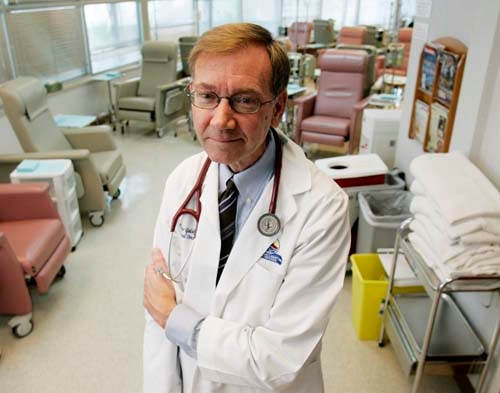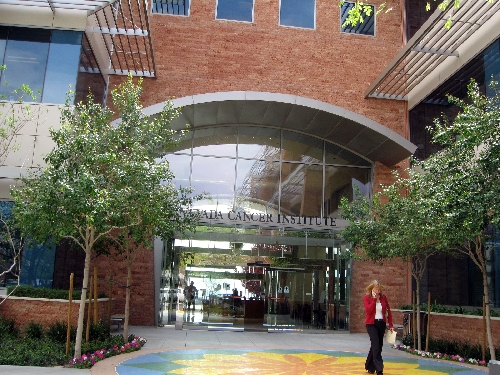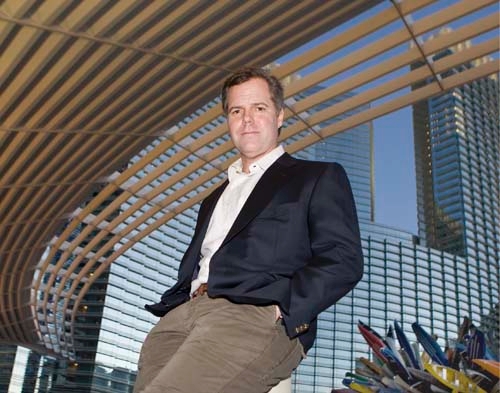Nevada Cancer Institute’s big dreams faded without funding




Dr. Nicholas Vogelzang, the first medical director of the Nevada Cancer Institute, will never forget how his association with the nonprofit medical center began.
Soon after the former director of the prestigious University of Chicago Cancer Research Center landed at McCarran International Airport in 2004, he met then-Gov. Kenny Guinn.
He saw the iconic rock band the Eagles perform at a fundraiser for the institute, met U.S. Sen. Harry Reid, D-Nev., and joked with Las Vegas Mayor Oscar Goodman.
"It was pretty heady stuff, just unbelievable," said Vogelzang, a world-renowned cancer researcher who worked at the institute for five years.
"Everyone just seemed so eager to help make the institute a success. I remember thinking to myself, ‘How could an institution with this much clout not succeed?’ It appeared to have too much support, would be too big to fail."
Vogelzang was caught up in the dream of institute founders Heather and Jim Murren, who hoped to build a world-class cancer research and treatment center in Las Vegas.
But on Dec. 2, Heather Murren announced that the financially troubled cancer institute, with its campus at the optimistically named address of 1 Breakthrough Way in Summerlin, had filed for bankruptcy protection and was being sold to the University of California, San Diego Health System, which already runs one of the country’s top cancer centers.
As he reflected on that announcement, Vogelzang, who left the Nevada Cancer Institute two years ago, wouldn’t say that their dream was dead.
"Ultimately, what they did may well be better for the city and state," said Vogelzang, who is still highly respected by the Murrens even though he now serves as an administrator, clinician and researcher for their chief competitor, the for-profit Comprehensive Cancer Centers of Nevada. "Jim and Heather were filled with enthusiasm and energy. I still have enormous respect for them.
"They started with the right idea. The execution was flawed, not their vision. It would be wonderful to have a world-class cancer research and treatment center here. We don’t know what UC San Diego will do here yet. They’re very good there. The ultimate resolution of this — history will judge."
To get a sense of how the institute got to this juncture and where it will go from here, the Review-Journal talked to academics, physicians, researchers, bankers, hospital administrators, lawmakers and institute officials.
Some individuals requested anonymity because of litigation involving the institute or for business considerations.
When fundraising for the institute began in the early 2000s. Heather Murren, a former Wall Street stock analyst, painted a vision of building a cancer center in the image of the renowned MD Anderson Cancer Center in Houston.
Some questioned whether that dream was grounded in reality in Nevada, where reliable government funding can’t be counted on. Repeatedly, these same people, both public officials and businessmen, questioned whether the business model was sound.
SEEING OPPORTUNITY
Jim Murren, chairman and CEO of MGM Resorts International, bristles at the notion that the institute failed, that the energy and millions of dollars donated to it by Nevadans went down the drain.
He points, for instance, to research labs and treatment spaces that scientists and physicians — even those competing with the institute — agree are second to none, to the more than 17,000 people treated, some in first-time clinical trials.
But mostly he points to the opportunity he sees in the planned sale of Nevada Cancer Institute to UC San Diego, which operates the Moores Cancer Center in La Jolla, Calif. Established in 1979, Moores is one of only 40 National Cancer Institute-designated Comprehensive Cancer Centers in the United States.
The Nevada Cancer Institute, which opened to the public in 2005, had hoped to earn the prized designation in 10 or 15 years, Murren said.
Now, because of the institute’s planned affiliation with UC San Diego, he said Nevadans will get access to care overseen by a health system that has already earned the prized designation, which is reserved for centers with the highest achievements in cancer research, clinical care, education and community contributions.
Studies show that patients have better outcomes from treatment at National Cancer Institute-designated centers.
"This sale accelerates what we had planned," Jim Murren said. "Life has a funny way of working out."
But at this point no one knows for sure whether UC San Diego plans to directly affiliate the Nevada Cancer Center with the Moores center, or whether there will even be a local surgical component, which plays a key role in the national designation.
UC San Diego spokeswoman Jacqueline Carr said university administrators won’t comment on plans for the Nevada Cancer Institute until the sale is finalized.
Michael Yackira, chairman of the institute’s board of directors, said that even if the Nevada center isn’t directly woven into the fabric of the Moores center, Nevadans would still benefit from the expertise of UC San Diego’s protocols.
NEVADA’S STRUGGLES
That the institute will be taken over by a California institution both relieves and saddens state Sen. Sheila Leslie, D-Reno, who has championed health issues in Nevada.
"I’m relieved that services of the institute are going to continue," she said. "I don’t think the investment completely failed. It is indicative of Nevada wanting to have top-level facilities and not being able to adequately fund them. It kind of riles you that our university can’t have the capacity to acquire the institute but an out-of-state university does."
Leslie said an antiquated tax structure makes it difficult for state government to cover basic services for Nevadans, let alone aid a state-of-the-art medical center startup. By comparison, MD Anderson, affiliated with the oil-rich University of Texas system, has enjoyed a steady stream of state funding for decades.
She said the Murrens, who both lost loved ones to cancer, "may have overreached in terms of what they wanted to provide and what resources were available."
Leslie said it is understandable that the pair, both highly respected for demanding excellence in the business community, wanted the best doctors and best facilities. But she said for that you must have reliable, consistent funding.
Philanthropic efforts, which the Murrens excelled at, could never be enough over the long term, Leslie said.
Leslie said when the charismatic Murrens came to public officials requesting some funding aid in the early 2000s, before the state’s deep financial crisis, the Legislature "may have overreached, too."
"They sold a vision that everyone desperately wanted to buy into," she said. "We worried about giving to a private enterprise, but it would be nice to be known for something other than gaming."
She recalled that then-Gov. Guinn freed up $10 million in the budget for a one-time contribution. Before the institute even opened, the Nevada Legislature named it the state’s official cancer institute, one that would have outreach and education offices in Elko, Fallon and the Reno-Sparks area.
The state later appropriated another $10 million, but no steady funding stream was ever adopted in the state budget. Long a favorite of Reid, the institute received $40 million in a variety of appropriations from the federal government.
The institute initially secured a five-year loan and then renegotiated it for another five years. The $100 million loan came due earlier this year, making the institute’s financial problems even more acute. Those loans were relatively short term for a nonprofit, which often can acquire bond funding with terms that stretch to 20 years or more.
"The landscape at the state and federal level would not have made that possible at that time," Jim Murren said. "We wanted to get it open as soon as possible."
Chuck Elfsten, owner of Ocean Pacific Capital, a California firm that helps find financing for the building of medical centers, said a short-term loan without a lot of revenue coming in "isn’t realistic. … I don’t understand."
CHARISMATIC FUNDRAISERS
To Michael Jhin, CEO emeritus of the highly respected St. Luke’s Episcopal Health System that is part of the Texas Medical Center in Houston, the idea of trying to duplicate MD Anderson without considerable, consistent funding streams is "grandiose."
Only someone highly charismatic in fundraising could even get such an idea off the ground, Jhin said.
There is no question that fundraising for the institute was successful, with more than $240 million raised through galas that enjoyed the "wow factor" of celebrities such as Rod Stewart, Howie Mandel, Paris Hilton, Sylvester Stallone and Tommy Lee on hand. A foundation led by famed cyclist Lance Armstrong, who overcame testicular cancer, gave the institute a $500,000 gift.
In 2005, the Chronicle of Philanthropy gushed about the institute’s efforts: "The Nevada Cancer Institute, which has raised $65 million in less than three years of existence, is the most audacious new charity in a city that is churning out nonprofit organizations at a faster pace than all other urban areas except Atlanta."
But in 2008, just three years after the institute officially opened, it was in financial trouble, with a drop in fundraising given as the reason for 50 staffers being laid off. In 2007, the organization had generated a little more than $50 million in contributions, down from $66 million.
Both Jhin, of St. Luke’s in Houston, and Dennis Young, director of the nonprofit studies program at Georgia State University, said less than 10 percent of a medical center’s operations budget should come from philanthropy.
At the Nevada Cancer Institute, almost half the institute’s $62 million budget came from contributions, according to tax records for 2009, the most recent available.
Yackira, the institute’s board chairman, has cited the drop in philanthropic giving as a key reason half the 300 employees were laid off in April and the institute was forced to file for bankruptcy.
The same 2009 tax records show the institute cutting $9 million in expenses in one year, including $4 million in salaries. It’s not unusual for doctors and researchers to make $300,000 or more a year.
The institute also cut its losses by almost $4 million to $970,000. But it still owed the banks more than $100 million.
In bankruptcy filings this month, the institute claimed $91 million in debt to a group of secured lenders headed by Bank of America.
Vogelzang said he was concerned about leaning so heavily on philanthropy for operations.
"I mentioned that wasn’t done at the University of Chicago and was told this isn’t the University of Chicago," he said.
But he also understood why it was done.
Referrals from doctors for chemotherapy and radiation oncology were less than expected. Research grants were down. Negotiations with insurance companies over plans allowing their patients to come to the institute weren’t as successful as expected. A hoped for surgery center, which would bring in steady revenue from expensive cancer procedures, never materialized. And, as has long been the case in the medical arena, reimbursement for services from Medicare and other insurance plans was less than expected.
"We expanded too fast," Vogelzang said, "and unfortunately there was no real planning for a rainy day."
REFERRALS NEEDED
A number of doctors have told the Review-Journal that they didn’t refer patients to the institute because they didn’t appreciate what they regarded as criticism leveled at the local medical community by members of the institute.
Heather Murren said in April the institute may not have worked on local partnerships as "broadly and assiduously" as possible, and conceded that the number of referrals wasn’t as high as she would have liked.
But officials with the institute say the idea that local doctors were "bad-mouthed" for the their care is unfair.
In 2005, not long after the institute began official operations, Heather Murren told the Review Journal that a catalyst for its opening was that "data was showing that mortality rates (in Nevada) were higher than average, outcomes weren’t as good, and people left the state for treatment. That’s not what we want in Nevada."
Institute officials say those were simply the facts and were not meant as criticism of the local medical establishment. They also say it’s easy to find doctors who support the institution’s mission.
Dr. Avi Weiss, for example, said he and others are true believers in what the Nevada Cancer Institute wants to do.
"If it works, we’re a better community for it," said Weiss, whose practice, Urology Specialist of Nevada, rented office space from the institute,
Dr. James Sanchez is practice president of Comprehensive Cancer Centers of Nevada, which is the biggest group serving cancer patients in Southern Nevada with 45 percent of the market.
He said there is no doubt that many local physicians refused to refer patients to the institute because of what they believed was "bad-mouthing."
However, an institute official said Sanchez and others with their top competitor twisted what was said by institute officials to gain favor with local physicians.
"They made it more personal, " said an institute official.
Sanchez also said that without the backing of a major medical school’s academic medical center it was nearly impossible for a National Cancer Institute-designated cancer institute to exist in Las Vegas.
"Their vision was much larger than we’re capable of in our environment," he said.
Had a surgical component been available to the institute, it is possible that the institute would not have run into such dire financial straits, officials with the institute say. But because of economic challenges, the institute decided not to pursue a free-standing hospital.
LOOKING AT PARTNERS
Jim Murren said the Lincy Foundation, which had long been a benefactor of the institute, had been willing to put up $50 million for a new hospital, but even that was not enough to fund a free-standing hospital.
Instead, he said, the institute opted to try to forge a partnership with a local hospital on "a hospital within a hospital concept."
But discussions with hospitals that would have seen a section of a hospital dedicated to institute patients never could be worked out. Negotiations would seem to be on the verge of success and then turn sour, an institute official said.
In 2009 the institute brought in Dr. John Ruckdeschel from Detroit as director and CEO, hoping he could use his expertise to duplicate the success he had at hospitals in Florida and Michigan.
Though Vogelzang was given a high-ranking position at the institute, he and Ruckdeschel did not see eye to eye on research efforts.
Vogelzang, whose practice brought both top clinical and research dollars to the institute, left.
Soon, so did Dr. David Ward, the first active member of the prestigious National Academy of Sciences in Nevada. He had brought major grant funding to the institute.
As it turned out, Ruckdeschel, who worked hard to get a surgery component for the institute, ended up crossing swords with the Murrens. He was fired just before the April announcement that the institute was laying off half of its 300-member staff in an effort to manage $100 million in debt.
Ruckdeschel, who largely declines comment about the institute because of litigation concerns, said only that time will tell whether UC San Diego can make a go of it in Las Vegas.
Jim Murren, who said the institute looked at a number of partners for the institute, including the Cleveland Clinic, feels sure the California institution will succeed.
He said UC San Diego officials plan to meet with local physicians and hospitals soon after the sale is complete.
A surgery center, probably done in concert with a local hospital, will probably come into play soon, Murren said. And he expects prevention and educational programs to be carried out among the needy throughout the state.
Vogelzang, though he admits he didn’t appreciate how things worked out for him and others at the institute, wants the dream of the Murrens to live on.
Though he says there is excellent treatment now for patients, more can’t hurt.
"Frankly, I think it would be good for cancer patients in Southern Nevada. And that’s what we should be caring about."
Contact reporter Paul Harasim at pharasim@reviewjournal.com or 702-387-2908.












